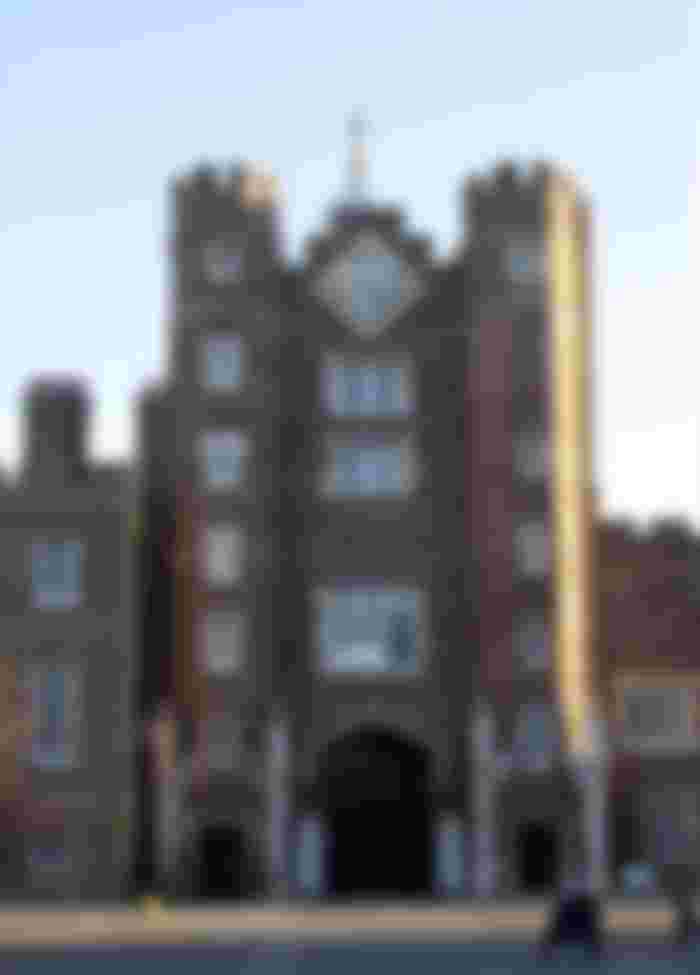St James' Palace

St. James' Palace, though no longer a Royal residence, is most interesting; partly because the British Empire is officially represented abroad in its name, but chiefly, I think, because it is, like Kensington Palace, a building where something approaching a succession of Kings and Queens have lived and died.
As regards its past, that is best learnt by a perusal of the Rev. Edgar Sheppard's (the Sub-Dean of the Chapels Royal) admirable and authoritative work on the subject.
To go through the Palace, a formal order must be obtained from the Lord Chamberlain's office, when Mrs. Martin, the courteous housekeeper, to whom it is usually addressed, will prove an admirable cicerone.
Her apartments are in Friary Court, where the Guard is relieved every morning, and where the bands were massed after the Trooping of the Colour on the late Queen's birthday.
Judging from the outside, it is hard to believe that the Palace is as big as it is. The principal state rooms face, on the south side, the charming old garden, a quiet spot with a sun-dial in the middle, and inviting lawns whereon monarchs have often strolled, and courtiers intrigued.
Queen Anne's room is the first in order, the next being the ante-drawing-room, which leads by three doors into the Throne-room, an apartment richly decorated and upholstered, but disappointingly small, the Throne beneath its canopy looking almost insignificant.
Beyond is, what is called, the Queen's Closet, where, as in the Throne-room, the tall narrow windows are splendidly draped.
The stately Banqueting-Hall - very rarely used for festive purposes, but where various Royal Guilds of needlework used to be permitted by the late Queen to display the clothing they made during the year for the poor - the Tapestry-room next to Queen Anne's room, whence the Sovereign on accession is proclaimed and presented to the public; the Guard-chamber, the Great Staircase; the Entree Gallery, and the Chapel, are all well worth a prolonged visit, which, however, is, as a rule, impossible.
Of pictures there are many; the greater number of a dark and depressing aspect, full-length portraits of monarchs by Holbein, Zucchero, Van Dyck, etc.; but there are some more enlivening ones of Royalties by modern painters, and an interesting portrait of the unfortunate Admiral Byng.
In most of the rooms are imposing fire-places with armorial bearings, one of the characteristics of Tudor-Elizabethan buildings, and when filled with piles of glowing coal and beech logs, most fine in effect.
Along a narrow stone corridor leading from the state apartments to the Palace, Mrs. Martin would take the visitors in her charge, to see the Royal Closet, which monopolizes one end of the Chapel Royal.
Its occupants can be seen only by the officiating clergy, and by the members of the household and others sitting in the galleries on the right of the Royal Closet.
Architecturally, the Chapel Royal has little worth noting beyond its fine ceiling painted by Holbein; but its altar-plate is magnificent, and its choral services, perfection, while its records of Royal weddings, christenings, and confirmations, alone suffice to invest it with historical interest.
Perhaps its most touching associations are with George III, whose unceasing attendance at early prayers in all weathers, wore out not only his wife and family, but every one else; and much sympathy must have been felt for the unfortunate equerry compelled to be present even when half-frozen with cold.
Everybody has heard how the old king beat time to the anthem with his music-roll, letting it drop upon the powdered heads of the pages below if he saw them talking, or inattentive.
The Royal kitchen, a fine old place with vaulted ceiling, is seldom shown to visitors, though it is possible, by the exercise of a little diplomacy, to get a peep at it.
The Courts are a great feature of St. James', which in the old views is represented as a series of low building arranged in quadrangles, with a frontage to the park, and a façade on the north side. Friary Court has been already referred to.
In Colour Court are placed the colours of the guard of honour; in Ambassador's Court is the town-house of the Duke of York; and in Stable Yard beyond, are the offices of the Lord Chamberlain.
About one-half of the Palace is taken up by the residences of the late officials. Some of these in the older portions of the rambling structure must be of considerable antiquity, for when the cellars belonging to the Clerk Comptroller of the Royal Kitchen were being enlarged, and it was necessary to excavate beneath the outer walls and the pavement at Marlboro' Gate, there was disclosed at a depth of six feet from the surface an ancient stone coffin lying with its feet to the east.
There were traces of others, but they were left undisturbed; and their existence is unknown to the hundreds of persons who every day pass backwards and for wards from Pall Mall to the Park.
With all its sad and gloomy memories of former occupants, no wonder there are supposed to be ghosts at St. James' Palace!
It is notoriously salubrious, however, and its drainage is perfect. The great main sewer, of a good old age, is built of brick, and so lofty that a man can easily walk along it with his hat on. It was formerly directly connected with the Thames at Whitehall, and was, doubtless, resorted to in times of danger as a means of escape from the Palace.
Her late Majesty's cellars are beneath the southern front of St. James', and approached by a broad flight of stairs near the official quarters of the Royal Cellarer. They are some distance below the surface, amidst the foundations of the older buildings which stood here before the advent of Henry VIII.
The curiosity of the place, is what at first sight appears to be a rivulet of clear water, exposed to view by the raising of a ponderous flagstone, and which imagination suggests may possibly be the "fair running stream" on whose margin the old Leper Hospital of St. James' was built. But, alas! the practical Clerk of the Works pronounces it to be only a reservoir to carry off the excessive rainfalls!
There is nothing remarkable about the cellars. They are not even large, but everything is well-ordered and exact. The bins are of slate, a clean and enduring substance, and they contain the choicest vintages, many being presents from distinguished personages. From the Emperor of Austria, there is some real Imperial Tokay, that peculiar licqueur wine with a flavour of tea so seldom met with, and some Acqua d'Oro, whose particles of gold leaf float in the pellucid contents of the quaintly-shaped bottles.
I trust that any one who, by special favour, penetrates into this pleasant retreat, may be as hospitably treated as I was, and be privileged to drink the health of the Sovereign in one of the Royal cellars!
Imperial London, Arthur Henry Beavan, 1901
